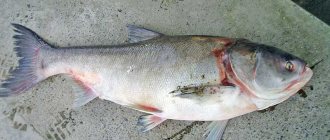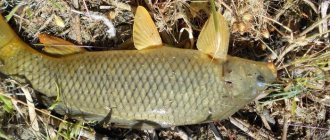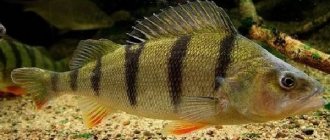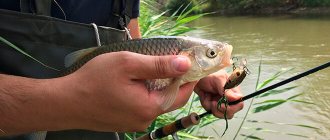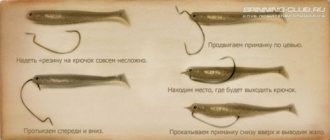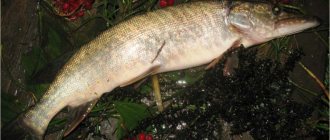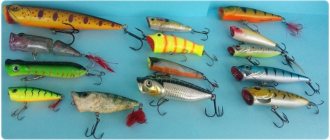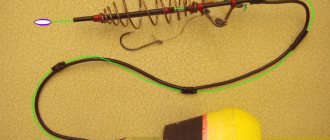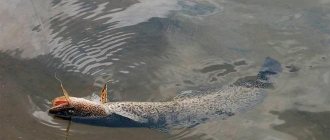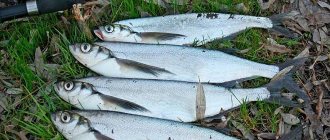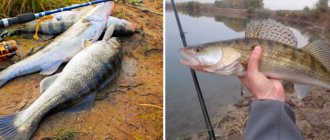Features of behavior
Catching silver carp is difficult in many respects due to the peculiarities of its behavior. Like most species of carp fish, this representative is a heat-loving individual, showing its activity at a water temperature of no lower than 18–20 degrees. Therefore, silver carp begin to bite no earlier than the end of May, when reservoirs are already steadily reaching temperatures close to optimal for adequate nutrition and comfortable existence of fish. The most important behavioral feature is the way the fish feed, which occurs purely in the water column or on the surface of the reservoir.
The fish itself is a purely vegetarian species, and if at least some animal component can be included in its diet, it will be bloodworms that accidentally got into the diet. The oral apparatus is built in the image of a whale's mouth, capturing food from the bottom up, filtering the water and collecting the smallest particles of plant plankton, which the individuals feed on. Consequently, feeding bait into the bottom layers will bring absolutely no results even in a huge school of this fish and will be ignored due to the banal impossibility of swallowing it.
This species is quite voracious and not very picky in choosing plant food, which is what pond holders often use to clean their reservoirs of annoying summer aquatic vegetation. Launched into such a stagnant pond, a flock of these vegetarians will gladly mow down the algae, stuffing their belly with it and at the same time intensively gaining kilograms of delicious and high-quality meat.
Silver carp behavior by month
You can catch silver carp throughout the open water season, but stable results are observed only in the summer months. This is explained by his food preferences and biological characteristics of fish. Its mouthparts are designed as a filter that allows water to pass through, filtering out zooplankton, detritus, microscopic algae and phytoplankton. And as you know, water bodies are saturated with these organisms at a stable high temperature.
Therefore, it is better to catch silver carp in the summer from the end of June, when stable hot weather sets in, the water warms up to a temperature of about 20 degrees, the reservoirs are covered with a sufficient amount of algae and filled with food for fish.
Photo 1. Fishing among the reeds with a float
Silver carp fishing is most productive in July. The fish behaves actively, does not overload with baits, and there is practically no decline in its bite. Good results this month are evidenced by numerous messages on thematic resources from different ponds and lakes.
Fishing for silver carp in August can also be effective if the weather is consistently hot. When it gets cold, the activity of the fish decreases and it becomes more difficult to catch them. In such a situation, you may not even see a bite during the day of fishing.
If September turns out to be hot, then the summer behavior of silver carp in ponds continues. It still continues to respond to offered bait, moves around the pond a lot, and feeds. But the more autumn comes into its own, the worse it is caught.
In winter, silver carp moves to deep areas, becomes passive and changes its habits.
The fish picks up the remaining algae from the bottom, which feeds on solid water throughout the entire season. It can only be caught from the ice by accident. Fishermen rarely manage to bring it to the surface, since initially the gear was not designed for such a weighty trophy. Note!
At dawn, the silver carp approaches the shore; during the day you need to look for it in the middle of the reservoir. The silver carp is considered a diurnal underwater resident. The best time of day to hunt it is the first half of the day. Moreover, it is not necessary to throw gear into the water at dawn. The fish starts to bite when the sun has risen high enough.
Habitats
Silver carp prefers a bottom with a soft muddy structure. On hard sandy soil it can be found only sporadically. It stands in areas with algae that are given to it. It will not stay in clean places, since there is nothing to profit from there.
For reference! If an angler wants to find silver carp in the river, then he needs to pay attention to areas with slow flows. The fish comes out onto the stream, but doesn’t stay there for long.
The depths at which you should catch silver carp in summer vary from 0.5 to 3 meters. In hot weather, the fish are in the water column or near the surface. When it gets cold, it sinks to the bottom and can sink to local pits up to 4–6 meters.
Food preferences
As mentioned above, the basis of the diet of silver carp is phytoplankton. These are microscopic algae that develop in summer when the weather is hot. In addition, zooplankton serves as a source of protein for fish. This representative of the ichthyofauna is considered the best ameliorator of water bodies, which is why many fish farm ponds are stocked with it.
Where to catch silver carp
For the most part, it is an inhabitant of shallow stagnant reservoirs with intensive aquatic vegetation. In those places where, with the onset of warm weather, water bodies begin to be covered with a thick carpet of aquatic vegetation, duckweed, elodea and hornwort, and blue-green algae bloom vigorously, most fish begin to feel not entirely comfortable, but not our hero. Just the opposite, silver carp loves water areas saturated with algae and happily stays in places where its highest concentration is felt. Typically, the fish occupy well-heated shallows with a water level of 1 to 5 meters, where they feed. The coastline, cut off by a wall of reeds or cattails, only adds perspective to the habitat, making it even safer and more secluded for the flock.
The individual is also attracted by the presence of a shallow current, where the water itself brings not only new portions of plankton, but is also richer in oxygen. Consequently, tributaries on weakly flowing rivers and streams flowing into ponds are considered suitable for fishing. Special places in reservoirs are underwater spits with a clean bottom, where fish like to approach from the depths along smooth slopes, looking for spots of nutritious turbidity and bask in the warm waters during cool mornings and prolonged periods of bad weather.
Important! As a rule, flocks of herbivorous giants feed throughout the daylight hours, with increased activity in the evening and late morning. A good catch of silver carp can be obtained on sunny days with slightly windy weather, when the reservoir is covered with ripples with a small wave hiding the fisherman himself and his activity.
Cold weather and prolonged rains significantly reduce the feeding activity of fish and lead to interruptions in their feeding for a couple of days until the weather completely stabilizes. Cooling water forces schools to descend to the depths, where catching this already elusive fish becomes an almost impossible task.
Catching silver carp with float tackle
Rod
Effective methods of catching silver carp are using Bolognese and match fishing rods. The rod is selected to be long, up to 8 meters. It must withstand and dampen the powerful jerks of large fish. You should not choose a delicate and snotty rod. It is better to give preference to a heavier, but far-throwing fishing rod. The rings should be large and have long stems. Basically, we need a carp rod.
Coil
We put a reel on the fishing rod with a spool capacity of 5000 to 8000. It must be powerful and withstand long fights with trophy specimens. A bayrunner is required. The silver carp is a strong fish, so large specimens can easily drag away the fishing rod. The Bayrunner will prevent such a misunderstanding. The friction clutch can be located both at the front and at the rear. Whichever is convenient for you. The main thing is that it ensures a smooth release of the line from the reel. We set the fishing line from 0.35 to 0.4. It is better to use a rigid, low-stretch vein.
Float
For catching silver carp with a fishing rod, a dim float with a long antenna is better suited. Too bright ones alarm the fish. To ensure effective fishing for silver carp, you should use a balsa float. It should not stand vertically. Ideally, it will lie, imitating a branch or sliver. In compacted reservoirs, silver carp are alarmed by “unnatural” objects.
The most commonly used is a spindle-shaped float with a balsa barrel. It is surrounded from below with several pellets. The upper part has a thick green antenna. The barrel is painted yellow or brown, similar to tree bark.
The float is attached to a clasp, that is, it floats. If the fishing depth does not exceed 5 meters, then you can use a float with blind equipment. Moreover, floats are suitable for match fishing. We simply thread silicone tubes of the required diameter onto the antenna and pass fishing line through them. We put 2-3 tubes.
Lure
In stores we buy such bait so that it dusts well. It should attract silver carp from the entire water column. There are specialized baits in geyser format. We add large particles to it: boiled peas, corn, pearl barley, green peas.
You can make your own bait. To do this, we will need 1 kg of premium flour, bran, powdered milk, as well as a bag of vanillin and 30 grams of starch. Take a large saucepan and add flour, milk powder, vanillin and starch to it. Then we dilute the resulting mass in boiled water.
Add water in small portions and stir constantly. You need to get a mass similar in consistency to sour cream. As soon as we get the required hardness, add bran and a little sand. Mix all this well and leave for 30 minutes. During this time the bait will be ready. We take her fishing. Fishing for silver carp using this bait is effective on bets and lakes with slow currents.
What is used to catch silver carp?
A vegetarian lifestyle dictates to the angler the direction of selecting baits for effective and successful fishing from a wide range of plant baits. The bait for silver carp, despite its size, is not massive and mostly consists of a couple or three specimens of the element selected for fishing.
Important! The priority ready-made baits are sweet canned corn kernels, which are strung in two or three pieces on the hook of the equipment, carefully hiding the sting, which is one of the nuances of catching this representative of carp.
Peas, which are used not only in canned form, but also in raw, so-called milk form, will also be a good bait for silver carp. Milk peas are shelled from the green pod, mounted on a hook similar to the above technique for mounting corn grains. Assorted vegetable baits made from pieces of finely chopped potatoes, cucumber, carrots and cabbage leaves show good results both when used in individual variants and when mixing baits.
An exotic but effective bait is diced porcini mushroom, which lures fish to the fishing point with its scent. In addition to vegetables, berries and fruits can also be used as bait. Preference here is given to chopped sweet apples, pears, raspberries, strawberries and pitted cherries. Balls of semolina and millet, as well as bread pellets, are suitable for catching silver carp with a fishing rod no less successfully. Directly at the hunting site, you can get such promising bait as a young shoot of reed or reeds. The sweet core, peeled from the peel, is caught at the moments when the rapid growth of this plant begins.
Technoplankton has become a modern innovative bait specialized specifically for this fish . The bait is concentrated and dusty in water, and is produced by manufacturers in the form of a special barrel with the possibility of fastening in installation. Once in the water, the nutrient particles peeling off from the base create a cloudy dust cloud with a high concentration of a certain aroma, attracting a school of fish to the fishing point. Among the popular aromas, it is especially worth highlighting honey, anise, vanilla and fruit flavors.
When the water cools, when fishing for silver carp is carried out in the fall, technoplankton is used with an attractant of fresh blood and fresh bloodworms, to which the original vegetarian begins to react, overstepping his principles in nutrition. Experienced fishermen prepare special dough compositions based on breadcrumbs and milk powder. The addition of dust to this mass makes the bait more flexible, which allows it to be securely attached to the hook. Often, ground dill seed is used as an attractant in the dough, and baking soda is added to the mix for a cloudy effect.
The most effective baits
Good catchability has been shown in practice by the use of artificial bait - technoplankton.
When going fishing for bighead, as experienced fishermen call silver carp, you should choose places where there is no rich vegetation in the reservoir. It is recommended to select baits that can create a kind of cloud of turbidity in the water.
This attracts the attention of large fish and they will definitely come up to eat. The basis of the silver carp diet is vegetation, so first of all, the fish should be offered bait based on plant components.
The most catchy vegetable baits:
- Corn (canned) – 2-3 pieces are strung onto the sting (depending on size). The latter should firmly cover the tip of the hook.
- Green peas are good both raw and canned. Wear 2-3 pieces.
- Vegetables cut into squares (cabbage, potatoes, carrots, cucumbers, porcini mushrooms).
- Semolina and millet cereals.
- Fruits and berries cut into squares (raspberries, strawberries, apples, pears).
- The bread balls are quite soft with an elastic crust.
- Reed shoots (young) - harvested right at the fishing site.
Animal-type baits are completely unsuitable for attracting the lobate. The fish is a herbivore and is simply not interested in live bait. As an exception, you can try casting a bloodworm attached to a hook. In some reservoirs, silver carp actively bite on it.
The assortment of technoplankton is completely diverse due to the presence of flavors. The following aromas showed excellent results:
- honey;
- anise;
- vanilla;
- fruit;
- the smell of blood;
- bloodworm smell;
Once in the aquatic environment, the barrel begins to collapse. Particles of food, peeling off from the overall pressed mass, lure the fish to the casting point, where the hooks are located in a cloud of turbidity.
The destruction of technoplankton differs markedly among different manufacturers. Some types are able to disintegrate within an hour, while others slowly peel off from the total mass almost overnight. This fact is definitely worth remembering when choosing bait.
Experienced fishermen are accustomed to using dough-like mixtures as bait. They are prepared with their own hands.
One of the most effective baits was a mixture based on breading:
- To prepare it, take 0.5 kg of crackers and 0.5 kg of milk powder.
- Add 4 tbsp. dried dill, 1 tbsp. flour and the same amount of cake (grain). Mix everything thoroughly.
- In a separate bowl, mix 1 tbsp. soda and 1 tbsp. acid (citric) and dissolve it in warm water. This mixture is poured into the total mass and kneaded until thickened.
- Then the pulp is added until the consistency of dough appears and kneaded well. This dough attracts large silver carp well.
In some reservoirs, fish go well on ordinary foam balls, placed on a hook in the amount of 2-3 pieces.
Lure
Without bait, fishing for a giant will be doomed to failure from the start. Bait for silver carp is a mandatory element in the fishing technique. Groundbait can be quite easily prepared at home from widely available ingredients.
The basis of the bait for silver carp is millet, from which the porridge is cooked and seasoned with the elements necessary for the aroma. Finely ground breadcrumbs, dry milk and macadamia are added to the porridge after cooking. The thoroughly mixed mixture will be ready for use after complete cooling. For bait you will need to purchase 3 kg of millet, one glass of flour, a kilogram of breadcrumbs and 250 grams of powdered milk; if you wish, you can recharge your homemade bait with a store-bought universal bait composition with any fruit flavor.
Another simple and effective option is complementary feeding based on boiled and crushed peas, to which semolina is added, and the mixed mixture is charged with fresh natural honey. For the composition, use 2 kg of peas, 3 kg of semolina and about 100 grams of honey.
Important! The finished bait should have a plastic consistency that does not stick to your hands and creates a clearly visible cloud when dissolved in water.
Excess bait mixture is stored frozen in the refrigerator for no more than two weeks.
What to catch silver carp with: the best baits and lures
Fishing for silver carp is a very exciting activity for both novice amateur fishermen and experienced fishermen with good experience.
Silver carp is a grassy and very cautious peaceful fish, when fishing for which you should always experiment with different baits, constantly selecting the most catchy one.
To catch it, you can use both bottom (feeder) tackle and a regular float rod, equipped for specific fishing conditions in a reservoir (mainly in strong currents).
The main elements of feeder gear for silver carp are a strong fishing rod (optimal length 2.5-3 m), fishing line (section diameter 0.20-0.24 mm), a feeder weighing up to 50-60 grams, hooks (suitable for No. 6 -7) and a sinker (average weight 20-25 g).
As a rule, this fish often likes to swim with its mouth open in a body of water, passing plankton through its gills, which is an excellent food for it.
Since silver carp is a schooling fish, before you start fishing, you must feed it well so that it approaches the fishing spot.
Also, you need to remember that silver carp is a fairly sensitive and very cunning fish, so bait should always be thrown into the water very carefully and quietly so as not to scare it off.
It bites most actively in fairly warm, hot summers, and with a sharp drop in water temperature, it begins to gradually lie to the bottom and practically does not bite on any bait.
The main ingredients of a good, catchable bait for silver carp are steamed pearl barley, canned peas and corn, which need to be periodically added to the fishing site.
How to catch silver carp
To carry out the hunt, fishermen have adapted several basic fishing methods, which include specialized float gear for silver carp, modernized bottom equipment for the specifics of fishing, as well as one of the most progressive methods, the so-called silver carp killer gear in the fishing community, which allows productive catching of the trophy. The basis of all these methods is the equipment on a powerful rod, which allows it to withstand high loads from playing strongly resisting large fish.
Important! In practice, fishing can be done both from the shore and from a floating craft, but often hunting from boats is not so successful due to the strong shyness of the fish and, if possible, when planning strategies for fishing sessions, it is better to initially rely on shore-based installations, looking for a promising fishing area.
In the following sections of the article, we will take a closer look at each fishing method, focusing on the configuration of the gear, its main advantages and disadvantages under certain fishing conditions.
Silver carp killer tackle
Fishing for silver carp with a high degree of efficiency is made possible by equipment designed by fishermen for catching fish in the surface layers of a reservoir. It is not without reason that the tackle, nicknamed the killer, is highly productive due to the adjustment of the equipment with the supply of bait according to the principle of natural feeding of our vegetarian, who, starting to absorb the aromatic and high-calorie dregs, swallows the hooks served with the delicacy during this activity, not suspecting any danger.
With this equipment you can catch silver carp in autumn and summer with equal success. The structure is fed into the fishing zone with a match rod with a dough of at least 70 grams with a soft action. The fishing rod is equipped with a carp reel with a high pulling force and a capacious spool, with the obligatory presence of a baitrunner. The installation itself is a construct that includes a massive float of about 35–50 grams, a capacious feeder with neutral buoyancy and a sliding weight that acts as an anchor. Assemble the installation on a monofilament transparent fishing line with a diameter of at least 0.3 mm.
Catching silver carp video
Catching silver carp using technoplankton video
Fishing for silver carp using technoplankton (phytoplankton). Master class “About fishing seriously” video 267. As soon as the hot days arrive, it’s time to catch silver carp. We have never hunted for this fish with a fishing rod, but we hope to catch it together with expert Roman Omelchenko.
Catching silver carp on technoplankton with a float video
Fishing for silver carp with float tackle. 12-hour fishing for silver carp for technoplankton “Royally”. A story about how to assemble gear online, casting gear, baiting the fishing spot, landing fish.
How to make tackle for catching silver carp video
Bottom tackle for catching silver carp video: This video shows how to make bottom tackle for catching silver carp using technoplankton.
The video shows how to make equipment for catching silver carp. Fishing for silver carp is very interesting, since silver carp is a strong fish and every fisherman would like to compete with a worthy opponent. Previously, it was believed that silver carp could only be caught with nets, but now there are practically no fishermen who have not caught them.
Source: fish-haus.ru
Silver carp nets
Fishing at different times of the year
They begin to catch this heat-loving fish in mid-May, after the water temperature has stabilized within 18 degrees. In early spring, after the ice melts, the vegetarian flocks are not active and still stand in the depths, in their wintering areas. Fishing for silver carp in summer is especially promising. In June, there are clearly visible bursts of zhora with fish approaching the shallows in search of young growth of sweet reeds and cattails. In the subsequent summer months, the bite becomes stable throughout the daylight hours, but especially good results are obtained from fishing from 4 to 9 am, when the most cautious and especially large individuals can be caught.
Fishing for silver carp in the fall does not differ in the regularity of the bite. As the water gets colder, the fish move to deeper parts of the reservoir and go out to feed cyclically, best on sunny and warm days that come after unfavorable weather. At such moments, fishermen keep watch in the shallows in the afternoon, when the water becomes warmer.
The last voles and the capture of a trophy can occasionally be had in the first ten days of November, and then you manage to get specimens that do not differ in special dimensions. Catching silver carp in winter is completely hopeless. When the water temperature drops below 10 degrees, the fish go into wintering pits and become numb, completely stopping feeding.
Fishing places
In the autumn, you should not hope to meet silver carp in shallow water areas, in the coastal zone, near hills and shallows. In rivers, fish are located in areas with slow flows, where the bottom is muddy or clayey. Less commonly found on rocky and pebble soil. The depths where you should look for this giant range from three to six meters.
As the weather warms up on sunny days, fish may move to shallow places where aquatic vegetation still remains. Schools of small roach, which concentrate in areas with preserved algae, can suggest a promising area for catching silver carp.
In lakes and paid ponds, silver carp fishing in the fall is carried out at some distance from the shore. It is advisable to first study the bottom topography and detect some local depth difference. It could be:
- a hill or bump;
- pit or groove;
- edge, ledge or drop.
Also, silver carp can be located in the area of a separate area with bottom algae or single submerged snags and branches.
